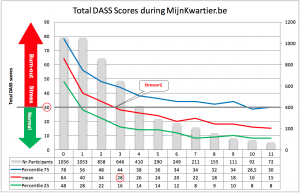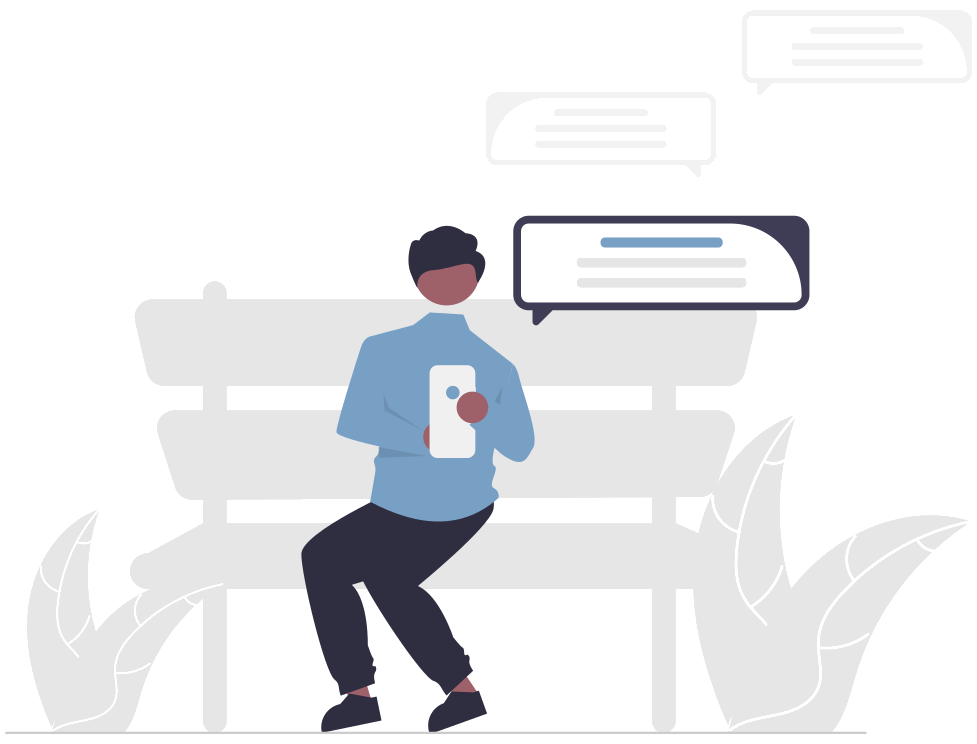Summary of our scientific research on the prevention and treatment of stress and burnout, which was proposed on the last Flemish Congress Scientific Health by the Flemish Union for Psychiatry: Study of 1.056 participants with stress, pre-burnout & burnout showed that the average participant is complaint-free in less than 3 weeks when they follow 15 minutes of online self-help therapy EVERY DAY. This gives a stress-reduction of more than 50% in 3 weeks.
Preventing: How can you prevent a burnout?
Scientifically seen, the chronic stress is the cause of an exhaustion of the brain (= burnout=. By solving this cause, you prevent and cure burnout. Prevent burnout by bringing down the stress into the 'green' region on the stress test, (red median below the 30 value in this graph) and to then continue until you are good at relapse prevention. The free test can be found on www.15Minutes4Me.com
What can employers do?
- Offer their employees a voluntary anonymous self-test, and in case this test indicates stress (orange or red), to offer a daily scientifically clinically proven self-help program which they can follow until their stress-indicator is back in the green (= normalized).
- Employers can offer to reimburse this program for their employees. Employees can verify the effective engagement and useful use of their investment as only the participants who effectively partake every day receive a "participation certificate" (with a toleration margin of 20%). This way, mis-use of unnecessary costs are avoided.
What can employees do?
Let themselves be guided by a medically scientifically proven program which can give us numeric values (to avoid being swept away by a hype or un-scientific 'philosophy'). Daily engagement is needed to ensure good results. Discussing their development with their doctor and workplace medic under medical confidentiality at the hand of the weekly evolution report with progression graphs so that the medic can follow-up how the stress-sufferer develops, and so that rare other causes can be ruled out.
CURATIVE approach: How do you recover from burnout?
Burnout is cured by ending up in the green normal-zone in the graph on the stress test + by continuing until you have mastered relapse prevention. The participant then goes through the following stages:
- Resting and healing until the indicators are in the green with the help of fifteen minutes of daily self-help
- Relapse prevention: learning and practising it, 15 minutes per day
- Re-integration preparation and discussions with your workplace medic, HR, and boss, guided by the online re-integration modules
- Re-integration period: implement it, often in a way where you build it up after discussing it with your doctor, workplace medic, HR, and boss, and possibly taking a step back sometimes before relapse occurs.
- After-care:
- After a real burnout, 6 months of follow-up and relapse prevention are needed for the participant in (expected) moments where (near)relapse lurks. Most participants experience 3 or 4 near-relapse periods during these 6 months, which they learn to recognize in time in order to preventively steer clear. In case this protocol is fully gone through, the chance of an actual relapse in the future becomes very unlikely after these 6 months.
- New competence building: During this after-care, participants learn the (self)management skills online which they need to deliver the desired professional output without being under negative stress: time-management, priority management, win-win discussions without leaving your chef or company out in the cold, cooperative skills, self-confidence, convincing skills, relational skills for at work or at home
In the graph you can see that the average participant (red line) crosses the "curing line" within 3 weeks.
 Preventing and treating burnout and stress: study
Preventing and treating burnout and stress: study
Those in deeper depression or burnout stages need an average of 8 to 12 weeks of DAILY proper guidance. The horror stories which go around taking 6 to 12 months with frequent relapses are often caused by non-professional guidance and help. The participant discusses their development under medical confidentiality with their doctor and workplace medic at the hand of the weekly evolution graphs which they receive from the program. In the online guidance, stress-sufferers can, if they want, invite their partner or family members to support them. This support figure then, among other things, receives online lessons and tips and supporting-skills, and a supportive communication is guided by the program. On the other hand, they can invite their boss on a non-conditional and free basis online for a series of videos with re-integration and guidance tips, so that the boss gains more insight and tips when it comes to the re-integration process.
RE-INTEGRATION at work? Which elements need to be considered when you go back to work after a long-term absence?
In case the employee is not professionally guided according to the step-by-step plan in the above protocol, the risk is large that they start going back to work too early or want to get back at 100% right away. That is why this phase needs to be guided by daily self-reflection and lessons in the re-integration process, together with evaluative conversations with doctor and workplace medic.
Self-knowledge of the employee
For the employee it is important that they learn to estimate what they can do (via a program or guidance), and preferably to "test" from home in advance under (self)guidance to see if their estimation is correct. In the beginning, this estimation is most often not correct and needs to be altered by the program or the guiding doctor.
Negotiation skills of the employee
Except for learning to set one's own limits (which start out being much lower than the patient thinks - until they have learned about then), they need to learn to respectfully discuss these with their boss in order to negotiate a flexible build-up schedule which respects the needs (limits) of their body as well as the priorities and needs of the company, in order to arrive at a useful form or return for both parties.
The workplace medic
The workplace medic can make their expertise available if this is accepted by the HR and leaders, and explain to the employer that expecting too much is harmful to both the employer themselves and to the employee. Looking for a win-win balance is difficult.
The person in charge
The person in charge needs some sort of 'education' on what burnout is and how to deal with it. That is the reason why a good program offers the employee the option to invite the employer to a (free) educative module where they learn what happens scientifically in the brain and how cooperation and re-integration can be organized in such a way that it is as good a process as possible for both parties (both human and financial). The quality of this build-up can make it so that the employee does not relapse anymore, in case this is done properly. An open dialogue along the way should allow the employee to discuss the situation with their employer in case of near-relapse, so that this can preventively be dealt with so that a real relapse is prevented, as are the costs attached to it.
What is burnout?
Burnout is an exhaustion of the brain (and the body) caused by chronic stress (long-term heightened 'cortisol' hormone in the blood) meaning that some brain centers are 'poisoned' and become exhausted, having brain cell death as a result. The neurons which are damaged are responsible for memory, attention, and focus (hippocampus) and future-focused thinking, planning, time management, strategy, setting priorities, ... (prefrontal cortex) and optimism (left prefrontal cortex) and critical thinking (right prefrontal cortex). This explains most symptoms! Anyone who puts their brain under pressure (cortisol) for an extended period of time can get burnout, and the working rhythm which we inherited from the industrial revolution was more suited for physical work than for mental work, meaning our Western way of working strongly increases our risk.
How can the employee preventively and anonymously test themselves?
An online stress test is freely available on www.15minutes4me.com This test has been done by 300 000 Flemish and Dutch people by now.
Paul Koeck, MD















